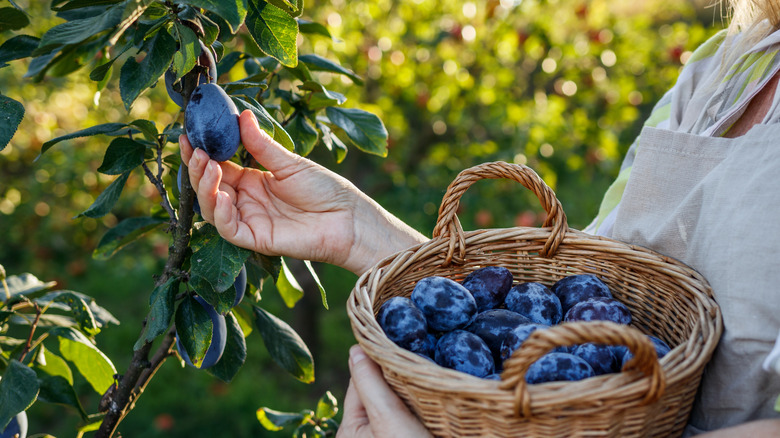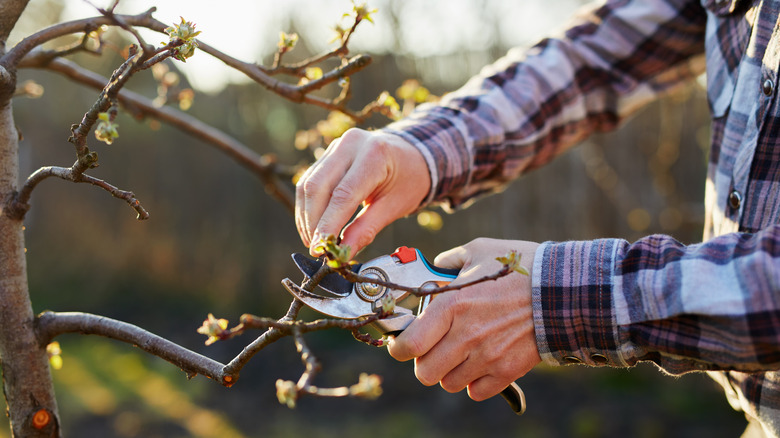How To Grow A Plum Tree In Your Yard As A Beginner Gardener
We may receive a commission on purchases made from links.
If you're new to gardening, a plum tree can provide a tasty introduction to fruit growing. Besides making nearby soil more fertile and gifting healthy food to your household, a plum is likely to forgive you if its growing conditions aren't perfect. Plums can adapt to many soil challenges and handle occasional water shortages when accustomed to your landscape. To start your fruitful journey, make sure you know everything you should before planting a plum tree and choose a variety likely to thrive in the area you call home.
European plums (Prunus domestica) are ideal for new gardeners because they're typically self-fertile. This means that you can get fruit if you plant just one tree. The 'Italian Prune,' a self-fertile European plum, is a terrific starter tree that makes loads of sweet, bluish-purple fruit. It performs well throughout the United States, in USDA hardiness zones 4 through 9, but it's happiest in western regions that don't get especially hot or cold. That said, this tree needs to chill at 45 degrees Fahrenheit or lower for at least 800 hours to produce fruit, so it's not ideal for regions with extremely mild winters.
If you live where cold weather is fleeting, go for a Japanese plum (Prunus salicina) cultivar, like the 'Methley'. Suited for hardiness zones 5a through 9b, this self-pollinating cultivar needs only 150 hours of chilling. Plus, it manages droughts better than most. It's even available as a semi-dwarf fruit tree that's perfect for smaller yards. Live in the Rocky Mountains or the Upper Midwest? Consider the 'Stanley,' a specialty Italian plum bred in Switzerland. It's unfazed by high altitudes and frigid temperatures.
Plum-growing pointers for new growers
Before you bring your new plum tree home, choose a top-notch planting site. Select a spot with full sunlight and soil that drains efficiently. Also, test your soil with a kit like the GiftBag 2-in-1 Complete Soil Test Kit, which can tell you if the soil has a pH or nutrient imbalance. If it does, a product like Jobe's Organics Fertilizer Spikes can help. If your soil is full of hard or sticky clay, mix it with compost and vermiculite as you dig the planting hole. Without this intervention, clay soil encourages standing water, which promotes rot.
Your plum tree's planting hole should be slightly wider and deeper than the tangle of roots at its base. Place your tree in this hole during early spring or fall, covering the root with soil, tamping down gently, and watering thoroughly. If you've chosen a full-size plum tree, leave at least 15 feet of space on each side so it can spread out.
Young, newly planted trees need regular watering, especially in hot, arid weather. They also benefit from applications of high-nitrogen fertilizer in spring and balanced fertilizer in summer. As your young tree grows, prune it in the spring, once it's no longer dormant and before it's covered in buds. Try to do this task during a stretch of dry weather, which reduces your tree's risk of developing a fungal disease called silver leaf. Also, learn how to spot and treat other common fruit tree diseases and pests, such as plum curculio worms. With excellent care, your plum tree should bear fruit three to six years after you plant it.

